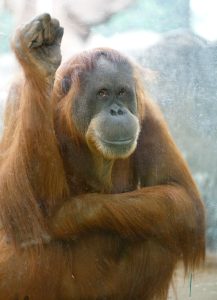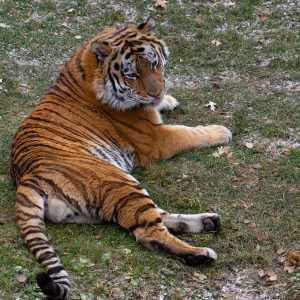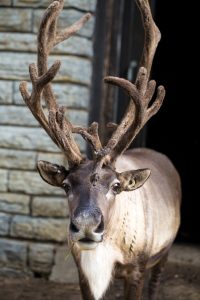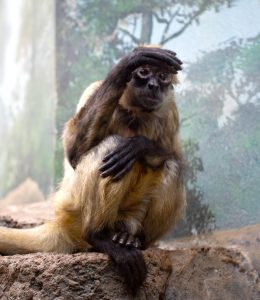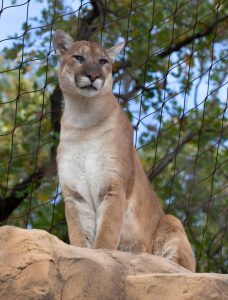Outstanding veterinary care can prolong the lives of animals like Daisy the giraffe. But for Como Zoo keepers, humane animal care can also make for heartbreaking decisions.
With more than a thousand animals of 215 different species in Como’s care, death is part of the natural life cycle at Como Zoo. Even so, recent months have felt especially challenging, as Como Zoo said goodbye to two iconic animals well known to and beloved by the public.
Last week, keepers made the difficult decision to humanely euthanize Daisy, a 23-year-old reticulated giraffe, who had been suffering from severe degenerative arthritis. A few months earlier, Como lost another beloved animal ambassador, 46-year-old orangutan Amanda, who was diagnosed with an inoperable abdominal mass that was causing chronic damage to her kidneys.
“Daisy was a strong, beautiful matriarch – quick to judge and slow to accept her human coworkers,” says Como Zoo senior keeper Jill Erzar. “She was a fierce and protective mother who would do anything to keep her calves safe. She was an extraordinary ambassador for giraffe, helping us connect visitors to her wild counterparts by telling her story.”
A fixture at Como Zoo, famous for her art work and her flair with textiles, Amanda the orangutan, who died at 46, was the quintessential animal ambassador, a gregarious great ape who helped to personalize nature while inspiring visitors to protect it.
Losses like this are hard on the whole zookeeping staff, says Erzar. “But being transparent about these events is an important way to tell the public about how much effort goes into life and death decisions about animal care,” she says, noting that there’s an even longer list of Como Zoo animals whose lives were saved or improved by major interventions over the last year. Below is a look at a few of them:
Dental Surgery for Tsar: A few years ago, Tsar the tiger went into cardiac arrest during a root canal and nearly died. “Dr. Fausto Bellezzo, our veterinarian at the University of Minnesota, jumped on him and did the most heroic CPR to bring him back,” says Erzar. “But we were very hesitant to immobilize him again.” When it became clear Tsar needed the procedure again in October, Como consulted with a team of tiger experts to help minimize the high risks of putting large cats under anesthesia, preparing for “every possible scenario we could imagine,” says Erzar. With 17 keepers and specialists assembled, this year’s procedure went “like clockwork,” and the 9-year-old tiger is back on the prowl.
Hormone Therapy for Forest: When they’re growing, reindeer antlers are covered in a complex vascular network called “velvet” that sheds as the antler hardens. But without the usual surge of male hormones required to boost the process, Forest’s antlers bled extensively, causing the castrated reindeer to collapse on exhibit last year. “Como vet tech Andrea Persson raced in and got a tourniquet on him right way,” says Erzar. This year, keepers found a much simpler solution—a short-term hormone implant that’s helped the reindeer develop and drop his antlers according to schedule.
Cataract Surgery for Gomez: One of the longest-lived spider monkeys at Como, 31-year-old Gomez was also one of its most recognizable, coming directly up the bay window of his habitat and shading his eyes to get a better look at visitors. “For decades, he had cataracts that were infringing on his vision, and that was his unique way of dealing with light sensitivity,” explains primate keeper Em Brunmeier. In March, Gomez had successful cataract surgery that will allow him to see well into his golden years. “We still see him shade his eyes at times, but it’s more of a reflex or a little salute at this point,” says Brunmeier.
Helping Jasper Navigate: Orphaned in the wild and brought to Como Zoo in 2018, mountain lions Jasper and Ruby have always stayed close together, and this year, a medical exam may have found the reason. “Jasper has progressive retinal atrophy, retinal tissue that either never forms or is not connected quite right or is lost over time,” says Erzar. Knowing more about his visual impairment has helped keepers develop a better plan for his care, which will involve keeping him outdoors where he’s most comfortable. “We are very lucky he has Ruby and they are close, because we do see her help him out,” Erzar says, adding that while his functional blindness won’t hurt his quality of life, it may help visitors feel more connected to the cougar. “When you see an animal that’s dealing with a challenge that a lot of humans face as well, it helps build that connection and that empathy about what humans and animals have in common.”

